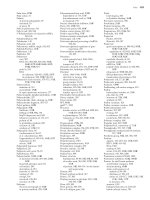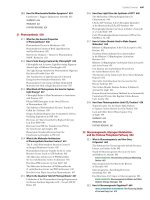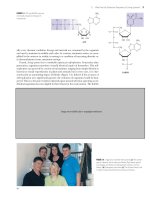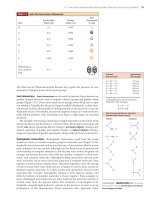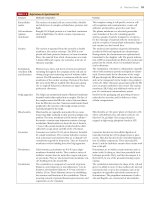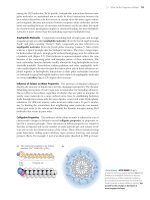Biochemistry, 4th Edition P6 potx
Bạn đang xem bản rút gọn của tài liệu. Xem và tải ngay bản đầy đủ của tài liệu tại đây (989.96 KB, 10 trang )
1.4 How Do the Properties of Biomolecules Reflect Their Fitness to the Living Condition? 13
cific than van der Waals interactions because they require the presence of com-
plementary hydrogen donor and acceptor groups.
Ionic Interactions Ionic interactions are the result of attractive forces between op-
positely charged structures, such as negative carboxyl groups and positive amino
groups (Figure 1.15). These electrostatic forces average about 20 kJ/mol in aque-
ous solutions. Typically, the electrical charge is radially distributed, so these inter-
actions may lack the directionality of hydrogen bonds or the precise fit of van der
Waals interactions. Nevertheless, because the opposite charges are restricted to ster-
ically defined positions, ionic interactions can impart a high degree of structural
specificity.
The strength of electrostatic interactions is highly dependent on the nature of the
interacting species and the distance, r, between them. Electrostatic interactions may
involve ions (species possessing discrete charges), permanent dipoles (having a per-
manent separation of positive and negative charge), or induced dipoles (having a
temporary separation of positive and negative charge induced by the environment).
Hydrophobic Interactions Hydrophobic interactions result from the strong
tendency of water to exclude nonpolar groups or molecules (see Chapter 2). Hy-
drophobic interactions arise not so much because of any intrinsic affinity of non-
polar substances for one another (although van der Waals forces do promote the
weak bonding of nonpolar substances), but because water molecules prefer the
stronger interactions that they share with one another, compared to their inter-
action with nonpolar molecules. Hydrogen-bonding interactions between polar
water molecules can be more varied and numerous if nonpolar molecules come
together to form a distinct organic phase. This phase separation raises the entropy
of water because fewer water molecules are arranged in orderly arrays around in-
dividual nonpolar molecules. It is these preferential interactions between water
molecules that “exclude” hydrophobic substances from aqueous solution and
drive the tendency of nonpolar molecules to cluster together. Thus, nonpolar re-
gions of biological macromolecules are often buried in the molecule’s interior to
exclude them from the aqueous milieu. The formation of oil droplets as hy-
drophobic nonpolar lipid molecules coalesce in the presence of water is an ap-
proximation of this phenomenon. These tendencies have important conse-
Atom
Van der Waals Covalent Represented
Atom Radius (nm) Radius (nm) to Scale
H 0.1 0.037
C 0.17 0.077
N 0.15 0.070
O 0.14 0.066
P 0.19 0.096
S 0.185 0.104
Half-thickness
of an aromatic 0.17 —
ring
TABLE 1.4
Radii of the Common Atoms of Biomolecules
C
OH
O
O
H
O
–
O
H
N
N
H
O
+
N
H
O
N
H
N
H bonds
Bonded atoms
0.27 nm
0.26 nm
0.29 nm
0.30 nm
0.29 nm
0.31 nm
Approximate
bond length*
Lengths given are distances from the atom
covalently linked to the H to the atom
H bonded to the hydrogen:
O
H
O
0.27 nm
Functional groups that are important
H-bond donors and acceptors:
C
OH
O
N
H
H
N
H
R
Donors Acceptors
CO
O
RR
O
H
N
PO
O
H
*
ANIMATED FIGURE 1.14 Some biolog-
ically important H bonds. See this figure animated at
www.cengage.com/login
14 Chapter 1 The Facts of Life: Chemistry Is the Logic of Biological Phenomena
quences in the creation and maintenance of the macromolecular structures and
supramolecular assemblies of living cells.
The Defining Concept of Biochemistry Is “Molecular Recognition
Through Structural Complementarity”
Structural complementarity is the means of recognition in biomolecular interac-
tions. The complicated and highly organized patterns of life depend on the ability
of biomolecules to recognize and interact with one another in very specific ways.
Such interactions are fundamental to metabolism, growth, replication, and other vi-
tal processes. The interaction of one molecule with another, a protein with a metabo-
lite, for example, can be most precise if the structure of one is complementary to the
structure of the other, as in two connecting pieces of a puzzle or, in the more popu-
lar analogy for macromolecules and their ligands, a lock and its key (Figure 1.16).
This principle of structural complementarity is the very essence of biomolecular recognition.
Structural complementarity is the significant clue to understanding the functional
properties of biological systems. Biological systems from the macromolecular level to
the cellular level operate via specific molecular recognition mechanisms based on
structural complementarity: A protein recognizes its specific metabolite, a strand of
DNA recognizes its complementary strand, sperm recognize an egg. All these inter-
actions involve structural complementarity between molecules.
Biomolecular Recognition Is Mediated by Weak Chemical Forces
Weak chemical forces underlie the interactions that are the basis of biomolecular
recognition. It is important to realize that because these interactions are sufficiently
weak, they are readily reversible. Consequently, biomolecular interactions tend to
be transient; rigid, static lattices of biomolecules that might paralyze cellular activi-
ties are not formed. Instead, a dynamic interplay occurs between metabolites and
macromolecules, hormones and receptors, and all the other participants instru-
mental to life processes. This interplay is initiated upon specific recognition be-
tween complementary molecules and ultimately culminates in unique physiological
activities. Biological function is achieved through mechanisms based on structural
complementarity and weak chemical interactions.
This principle of structural complementarity extends to higher interactions es-
sential to the establishment of the living condition. For example, the formation of
Ligand: a molecule (or atom) that binds specifi-
cally to another molecule (from Latin ligare, to
bind).
Protein strand
Magnesium ATP
–
OPO
Mg
2+
O
–
O
PO
O
–
O
CH
2
PO
O
–
O
O
OHHO
N
N
N
N
NH
2
Intramolecular ionic bonds between oppositely
charged groups on amino acid residues in a protein
NH
3
+
H
2
CC
O
–
O
H
2
CC
O
O
–
+
H
3
N
(CH
2
)
4
COO
–
ANIMATED FIGURE 1.15 Ionic bonds
in biological molecules. See this figure animated at
www.cengage.com/login
Puzzle Lock and key
Ligand
Ligand
FIGURE 1.16 Structural complementarity: the pieces of a puzzle, the lock and its key, a biological macromolecule
and its ligand—an antigen–antibody complex.The antigen on the right (gold) is a small protein, lysozyme, from
hen egg white.The antibody molecule (IgG) (left) has a pocket that is structurally complementary to a surface fea-
ture (red) on the antigen. (See also Figure 1.12.)
Courtesy of Professor Simon E. V. Phillips
Courtesy of Professor Simon E. V. Phillips
1.4 How Do the Properties of Biomolecules Reflect Their Fitness to the Living Condition? 15
supramolecular complexes occurs because of recognition and interaction between
their various macromolecular components, as governed by the weak forces formed
between them. If a sufficient number of weak bonds can be formed, as in macro-
molecules complementary in structure to one another, larger structures assemble
spontaneously. The tendency for nonpolar molecules and parts of molecules to
come together through hydrophobic interactions also promotes the formation of
supramolecular assemblies. Very complex subcellular structures are actually spon-
taneously formed in an assembly process that is driven by weak forces accumulated
through structural complementarity.
Weak Forces Restrict Organisms to a Narrow Range
of Environmental Conditions
Because biomolecular interactions are governed by weak forces, living systems are re-
stricted to a narrow range of physical conditions. Biological macromolecules are func-
tionally active only within a narrow range of environmental conditions, such as tem-
perature, ionic strength, and relative acidity. Extremes of these conditions disrupt the
weak forces essential to maintaining the intricate structure of macromolecules. The
loss of structural order in these complex macromolecules, so-called denaturation, is ac-
companied by loss of function (Figure 1.17). As a consequence, cells cannot tolerate
reactions in which large amounts of energy are released, nor can they generate a large
energy burst to drive energy-requiring processes. Instead, such transformations take
place via sequential series of chemical reactions whose overall effect achieves dramatic
energy changes, even though any given reaction in the series proceeds with only mod-
est input or release of energy (Figure 1.18). These sequences of reactions are orga-
nized to provide for the release of useful energy to the cell from the breakdown of food
or to take such energy and use it to drive the synthesis of biomolecules essential to the
living state. Collectively, these reaction sequences constitute cellular metabolism—the
ordered reaction pathways by which cellular chemistry proceeds and biological energy
transformations are accomplished.
Enzymes Catalyze Metabolic Reactions
The sensitivity of cellular constituents to environmental extremes places another
constraint on the reactions of metabolism. The rate at which cellular reactions pro-
ceed is a very important factor in maintenance of the living state. However, the com-
mon ways chemists accelerate reactions are not available to cells; the temperature
cannot be raised, acid or base cannot be added, the pressure cannot be elevated,
and concentrations cannot be dramatically increased. Instead, biomolecular cata-
lysts mediate cellular reactions. These catalysts, called enzymes, accelerate the re-
action rates many orders of magnitude and, by selecting the substances undergoing
Go to CengageNOW at www
.cengage.com/login and click BiochemistryInteractive
to explore the structure of immunoglobulin G, center-
ing on the role of weak intermolecular forces in es-
tablishing higher orders of structure.
Native
protein
Denatured
protein
ANIMATED FIGURE 1.17 Denaturation
and renaturation of the intricate structure of a protein.
See this figure animated at www.cengage.com/
login
16 Chapter 1 The Facts of Life: Chemistry Is the Logic of Biological Phenomena
reaction, determine the specific reaction that takes place. Virtually every metabolic
reaction is catalyzed by an enzyme (Figure 1.19).
Metabolic Regulation Is Achieved by Controlling the Activity of Enzymes Thou-
sands of reactions mediated by an equal number of enzymes are occurring at any
given instant within the cell. Collectively, these reactions constitute cellular metab-
olism. Metabolism has many branch points, cycles, and interconnections, as subse-
quent chapters reveal. All these reactions, many of which are at apparent cross-
purposes in the cell, must be fine-tuned and integrated so that metabolism and life
proceed harmoniously. The need for metabolic regulation is obvious. This meta-
bolic regulation is achieved through controls on enzyme activity so that the rates of
cellular reactions are appropriate to cellular requirements.
Despite the organized pattern of metabolism and the thousands of enzymes re-
quired, cellular reactions nevertheless conform to the same thermodynamic princi-
ples that govern any chemical reaction. Enzymes have no influence over energy
changes (the thermodynamic component) in their reactions. Enzymes only influ-
ence reaction rates. Thus, cells are systems that take in food, release waste, and carry
out complex degradative and biosynthetic reactions essential to their survival while
operating under conditions of essentially constant temperature and pressure and
maintaining a constant internal environment (homeostasis) with no outwardly ap-
parent changes. Cells are open thermodynamic systems exchanging matter and energy with
their environment and functioning as highly regulated isothermal chemical engines.
The Time Scale of Life
Individual organisms have life spans ranging from a day or less to a century or more,
but the phenomena that characterize and define living systems have durations rang-
ing over 33 orders of magnitude, from 10
Ϫ15
sec (electron transfer reactions, photo-
The combustion of glucose: C
6
H
12
O
6
+ 6 O
2
6 CO
2
+ 6 H
2
O + 2870 kJ energy
(a) In an aerobic cell
2 Pyruvate
6 CO
2
+ 6 H
2
O
Citric acid cycle
and oxidative
phosphorylation
Glycolysis
30–38 ATP
(b) In a bomb calorimeter
2870 kJ
energy
as heat
6 CO
2
+ 6 H
2
O
ATP
ATP
ATP
ATP
ATP
ATP
ATP
ATP
ATP
ATP
ATP
ATP
ATP
ATP
ATP
ATP
ATP
ATP
ATP
ATP
Glucose
Glucose
ACTIVE FIGURE 1.18 Metabolism is the organized release or capture of small amounts of
energy in processes whose overall change in energy is large. (a) Cells can release the energy of glucose in a
stepwise fashion and the small “packets” of energy appear in ATP. (b) Combustion of glucose in a bomb
calorimeter results in an uncontrolled, explosive release of energy in its least useful form, heat. Test yourself
on the concepts in this figure at www.cengage.com/login
ANIMATED FIGURE 1.19 Carbonic
anhydrase, a representative enzyme. See this figure
animated at www.cengage.com/login
1.5 What Is the Organization and Structure of Cells? 17
excitation in photosynthesis) to 10
18
sec (the period of evolution, spanning from
the first appearance of organisms on the earth more than 3 billion years ago to to-
day) (Table 1.5). Because proteins are the agents of biological function, phenom-
ena involving weak interactions and proteins dominate the shorter times. As time
increases, more stable interactions (covalent bonds) and phenomena involving the
agents of genetic information (the nucleic acids) come into play.
1.5 What Is the Organization and Structure of Cells?
All living cells fall into one of three broad categories—Archaea, Bacteria and Eu-
karya. Archaea and bacteria are referred to collectively as prokaryotes. As a group,
prokaryotes are single-celled organisms that lack nuclei and other organelles; the
word is derived from pro meaning “prior to” and karyot meaning “nucleus.” In con-
ventional biological classification schemes, prokaryotes are grouped together as
members of the kingdom Monera. The other four living kingdoms are all Eukarya—
the single-celled Protists, such as amoebae, and all multicellular life forms, including
the Fungi, Plant, and Animal kingdoms. Eukaryotic cells have true nuclei and other
organelles such as mitochondria, with the prefix eu meaning “true.”
The Evolution of Early Cells Gave Rise to Eubacteria, Archaea,
and Eukaryotes
For a long time, most biologists believed that eukaryotes evolved from the simpler
prokaryotes in some linear progression from simple to complex over the course of
geological time. However, contemporary evidence favors the view that present-day
organisms are better grouped into the three classes mentioned: eukarya, bacteria,
and archaea. All are believed to have evolved approximately 3.5 billion years ago
from an ancestral communal gene pool shared among primitive cellular entities.
Furthermore, contemporary eukaryotic cells are, in reality, composite cells that har-
bor various bacterial contributions.
Despite great diversity in form and function, cells and organisms share much bio-
chemistry in common. This commonality and diversity has been substantiated by
the results of whole genome sequencing, the determination of the complete nu-
Time (sec) Process Example
10
Ϫ15
Electron transfer The light reactions in photosynthesis
10
Ϫ13
Transition states Transition states in chemical reactions have lifetimes of 10
Ϫ11
to 10
Ϫ15
sec (the reciprocal
of the frequency of bond vibrations)
10
Ϫ11
H-bond lifetimes H bonds are exchanged between H
2
O molecules due to the rotation of the water
molecules themselves
10
Ϫ12
to 10
3
Motion in proteins Fast: tyrosine ring flips, methyl group rotations
Slow: bending motions between protein domains
10
Ϫ6
to 10
0
Enzyme catalysis 10
Ϫ6
sec: fast enzyme reactions
10
Ϫ3
sec: typical enzyme reactions
10
0
sec: slow enzyme reactions
10
0
Diffusion in membranes A typical membrane lipid molecule can diffuse from one end of a bacterial cell to the
other in 1 sec; a small protein would go half as far
10
1
to 10
2
Protein synthesis Some ribosomes synthesize proteins at a rate of 20 amino acids added per second
10
4
to 10
5
Cell division Prokaryotic cells can divide as rapidly as every hour or so; eukaryotic cell division varies
greatly (from hours to years)
10
7
to 10
8
Embryonic development Human embryonic development takes 9 months (2.4 ϫ 10
8
sec)
10
5
to 10
9
Life span Human life expectancy is 77.6 years (about 2.5 ϫ 10
9
sec)
10
18
Evolution The first organisms appeared 3.5 ϫ 10
9
years ago and evolution has continued since then
TABLE 1.5
Life Times
18 Chapter 1 The Facts of Life: Chemistry Is the Logic of Biological Phenomena
cleotide sequence within the DNA of an organism. For example, the genome of the
metabolically divergent archaea Methanococcus jannaschii shows 44% similarity to
known genes in eubacteria and eukaryotes, yet 56% of its genes are new to science.
How Many Genes Does a Cell Need?
The genome of the Mycoplasma genitalium consists of 523 genes, encoding 484 pro-
teins, in just 580,074 base pairs (Table 1.6). This information sparks an interesting
question: How many genes are needed for cellular life? Any minimum gene set must
encode all the information necessary for cellular metabolism, including the vital
functions essential to reproduction. The simplest cell must show at least (1) some
degree of metabolism and energy production; (2) genetic replication based on a
template molecule that encodes information (DNA or RNA?); and (3) formation
and maintenance of a cell boundary (membrane). Top-down studies aim to discover
from existing cells what a minimum gene set might be. These studies have focused
on simple parasitic bacteria, because parasites often obtain many substances from
their hosts and do not have to synthesize them from scratch; thus, they require
fewer genes. One study concluded that 206 genes are sufficient to form a minimum
gene set. The set included genes for DNA replication and repair, transcription,
translation, protein processing, cell division, membrane structure, nutrient trans-
port, metabolic pathways for ATP synthesis, and enzymes to make a small number
of metabolites that might not be available, such as pentoses for nucleotides. Yet
another study based on computer modeling decided that a minimum gene set
might have only 105 protein-coding genes. Bottom-up studies aim to create a mini-
mal cell by reconstruction based on known cellular components. At this time, no
such bottom-up creation of an artificial cell has been reported. The simplest func-
tional artificial cell capable of replication would contain an informational macro-
molecule (presumably a nucleic acid) and enough metabolic apparatus to maintain
a basic set of cellular components within a membranelike boundary.
Number of Cells
Organism in Adult* Number of Genes
Mycobacterium genitalium 1 523
Pathogenic bacterium
Methanococcus jannaschii 1 1,800
Archaeal methanogen
Escherichia coli K12 1 4,400
Intestinal bacterium
Saccharomyces cereviseae 1 6,000
Baker’s yeast (eukaryote)
Caenorhabditis elegans 959 19,000
Nematode worm
Drosophila melanogaster 10
4
13,500
Fruit fly
Arabidopsis thaliana 10
7
27,000
Flowering plant
Fugu rubripes 10
12
38,000 (est.)
Pufferfish
Homo sapiens 10
14
20,500 (est.)
Human
The first four of the nine organisms in the table are single-celled microbes; the last six are eukaryotes; the last five are
multicellular, four of which are animals; the final two are vertebrates. Although pufferfish and humans have roughly the
same number of genes, the pufferfish genome, at 0.365 billion nucleotide pairs, is only one-eighth the size of the human
genome.
*Numbers for Arabidopsis thaliana, the pufferfish, and human are “order-of-magnitude” rough estimates.
TABLE 1.6
How Many Genes Does It Take To Make An Organism?
Gene is a unit of hereditary information, physi-
cally defined by a specific sequence of nucleo-
tides in DNA; in molecular terms, a gene is a
nucleotide sequence that encodes a protein or
RNA product.
1.5 What Is the Organization and Structure of Cells? 19
Archaea and Bacteria Have a Relatively Simple Structural Organization
The bacteria form a widely spread group. Certain of them are pathogenic to hu-
mans. The archaea, about which we know less, are remarkable because they can be
found in unusual environments where other cells cannot survive. Archaea include
the thermoacidophiles (heat- and acid-loving bacteria) of hot springs, the
halophiles (salt-loving bacteria) of salt lakes and ponds, and the methanogens (bac-
teria that generate methane from CO
2
and H
2
). Prokaryotes are typically very small,
on the order of several microns in length, and are usually surrounded by a rigid cell
wall that protects the cell and gives it its shape. The characteristic structural orga-
nization of one of these cells is depicted in Figure 1.20.
Prokaryotic cells have only a single membrane, the plasma membrane or cell
membrane. Because they have no other membranes, prokaryotic cells contain no
nucleus or organelles. Nevertheless, they possess a distinct nuclear area where a sin-
gle circular chromosome is localized, and some have an internal membranous struc-
ture called a mesosome that is derived from and continuous with the cell mem-
brane. Reactions of cellular respiration are localized on these membranes. In
cyanobacteria, flat, sheetlike membranous structures called lamellae are formed
from cell membrane infoldings. These lamellae are the sites of photosynthetic ac-
tivity, but they are not contained within plastids, the organelles of photosynthesis
found in higher plant cells. Prokaryotic cells also lack a cytoskeleton; the cell wall
maintains their structure. Some bacteria have flagella, single, long filaments used
for motility. Prokaryotes largely reproduce by asexual division, although sexual ex-
changes can occur. Table 1.7 lists the major features of bacterial cells.
The Structural Organization of Eukaryotic Cells Is More Complex
Than That of Prokaryotic Cells
Compared with prokaryotic cells, eukaryotic cells are much greater in size, typically
having cell volumes 10
3
to 10
4
times larger. They are also much more complex.
These two features require that eukaryotic cells partition their diverse metabolic
Flagella
Capsule
Nucleoid (DNA)
Ribosomes
E. coli bacteria
A BACTERIAL CELL
FIGURE 1.20 This bacterium is Escherichia coli, a member of the coliform group of bacteria that colonize the
intestinal tract of humans. (See Table 1.7.) (Photo, Martin Rotker/Phototake, Inc.; inset photo, David M. Phillips/The Popula-
tion Council/Science Source/Photo Researchers, Inc.)
20 Chapter 1 The Facts of Life: Chemistry Is the Logic of Biological Phenomena
processes into organized compartments, with each compartment dedicated to a par-
ticular function. A system of internal membranes accomplishes this partitioning. A
typical animal cell is shown in Figure 1.21 and a typical plant cell in Figure 1.22.
Tables 1.8 and 1.9 list the major features of a typical animal cell and a higher plant
cell, respectively.
Eukaryotic cells possess a discrete, membrane-bounded nucleus, the repository
of the cell’s genetic material, which is distributed among a few or many chromo-
somes. During cell division, equivalent copies of this genetic material must be
passed to both daughter cells through duplication and orderly partitioning of the
chromosomes by the process known as mitosis. Like prokaryotic cells, eukaryotic
cells are surrounded by a plasma membrane. Unlike prokaryotic cells, eukaryotic
cells are rich in internal membranes that are differentiated into specialized struc-
tures such as the endoplasmic reticulum (ER) and the Golgi apparatus. Membranes
also surround certain organelles (mitochondria and chloroplasts, for example) and
various vesicles, including vacuoles, lysosomes, and peroxisomes. The common
purpose of these membranous partitionings is the creation of cellular compart-
ments that have specific, organized metabolic functions, such as the mitochon-
drion’s role as the principal site of cellular energy production. Eukaryotic cells also
have a cytoskeleton composed of arrays of filaments that give the cell its shape and
its capacity to move. Some eukaryotic cells also have long projections on their
surface—cilia or flagella—which provide propulsion.
Structure Molecular Composition Function
Cell wall
Cell membrane
Nuclear area or nucleoid
Ribosomes
Storage granules
Cytosol
TABLE 1.7
Major Features of Prokaryotic Cells
Peptidoglycan: a rigid framework of polysaccharide
crosslinked by short peptide chains. Some bacteria
possess a lipopolysaccharide- and protein-rich outer
membrane.
The cell membrane is composed of about
45% lipid and 55% protein. The lipids form a
bilayer that is a continuous nonpolar hydrophobic
phase in which the proteins are embedded.
The genetic material is a single, tightly coiled DNA
molecule 2 nm in diameter but more than 1 mm
in length (molecular mass of E. coli DNA is 3 ϫ 10
9
daltons; 4.64 ϫ 10
6
nucleotide pairs).
Bacterial cells contain about 15,000 ribosomes.
Each is composed of a small (30S) subunit and a
large (50S) subunit. The mass of a single ribosome
is 2.3 ϫ 10
6
daltons. It consists of 65% RNA and
35% protein.
Bacteria contain granules that represent storage
forms of polymerized metabolites such as sugars or
-hydroxybutyric acid.
Despite its amorphous appearance, the cytosol is an
organized gelatinous compartment that is 20%
protein by weight and rich in the organic molecules
that are the intermediates in metabolism.
Mechanical support, shape, and protection against
swelling in hypotonic media. The cell wall is a
porous nonselective barrier that allows most small
molecules to pass.
The cell membrane is a highly selective perme-
ability barrier that controls the entry of most sub-
stances into the cell. Important enzymes in the
generation of cellular energy are located in the
membrane.
DNA provides the operating instructions for the
cell; it is the repository of the cell’s genetic infor-
mation. During cell division, each strand of the
double-stranded DNA molecule is replicated to
yield two double-helical daughter molecules.
Messenger RNA (mRNA) is transcribed from
DNA to direct the synthesis of cellular proteins.
Ribosomes are the sites of protein synthesis. The
mRNA binds to ribosomes, and the mRNA
nucleotide sequence specifies the protein that is
synthesized.
When needed as metabolic fuel, the monomeric
units of the polymer are liberated and degraded
by energy-yielding pathways in the cell.
The cytosol is the site of intermediary metabo-
lism, the interconnecting sets of chemical reac-
tions by which cells generate energy and form the
precursors necessary for biosynthesis of macro-
molecules essential to cell growth and function.
1.6 What Are Viruses? 21
1.6 What Are Viruses?
Viruses are supramolecular complexes of nucleic acid, either DNA or RNA, en-
capsulated in a protein coat and, in some instances, surrounded by a membrane
envelope (Figure 1.23). Viruses are acellular, but they act as cellular parasites in
order to reproduce. The bits of nucleic acid in viruses are, in reality, mobile ele-
ments of genetic information. The protein coat serves to protect the nucleic acid
and allows it to gain entry to the cells that are its specific hosts. Viruses unique for
all types of cells are known. Viruses infecting bacteria are called bacteriophages
(“bacteria eaters”); different viruses infect animal cells and plant cells. Once the
nucleic acid of a virus gains access to its specific host, it typically takes over the
metabolic machinery of the host cell, diverting it to the production of virus parti-
cles. The host metabolic functions are subjugated to the synthesis of viral nucleic
acid and proteins. Mature virus particles arise by encapsulating the nucleic acid
Rough endoplasmic
reticulum (plant and animal)
Smooth endoplasmic
reticulum (plant and animal)
Mitochondrion
(plant and animal)
Smooth endoplasmic reticulum
Nuclear membrane
Nucleolus
Nucleus
Plasma
membrane
Golgi body
Filamentous cytoskeleton
(microtubules)
Cytoplasm
Mitochondrion
Lysosome
Rough endoplasmic reticulum
AN ANIMAL CELL
FIGURE 1.21 This figure diagrams a rat liver cell, a typical higher animal cell.
© Keith Porter/Photo Researchers, Inc.
Dwight R. Kuhn/Visuals Unlimited
D.W. Fawcett/Visuals Unlimited
22 Chapter 1 The Facts of Life: Chemistry Is the Logic of Biological Phenomena
within a protein coat called the capsid. Thus, viruses are supramolecular assem-
blies that act as parasites of cells (Figure 1.24).
Often, viruses cause disintegration of the cells that they have infected, a process
referred to as cell lysis. It is their cytolytic properties that are the basis of viral dis-
ease. In certain circumstances, the viral genetic elements may integrate into the
host chromosome and become quiescent. Such a state is termed lysogeny. Typically,
damage to the host cell activates the replicative capacities of the quiescent viral nu-
cleic acid, leading to viral propagation and release. Some viruses are implicated in
transforming cells into a cancerous state, that is, in converting their hosts to an un-
regulated state of cell division and proliferation. Because all viruses are heavily de-
pendent on their host for the production of viral progeny, viruses must have evolved
after cells were established. Presumably, the first viruses were fragments of nucleic
acid that developed the ability to replicate independently of the chromosome and
then acquired the necessary genes enabling protection, autonomy, and transfer be-
tween cells.
Chloroplast (plant cell only)
Golgi body (plant and animal)
Mitochondrion
Lysosome
Smooth endoplasmic
reticulum
Nuclear
membrane
Nucleolus
Nucleus
Rough endoplasmic
reticulum
Golgi body
Plasma membrane
Cellulose wall
Pectin
Cell wall
Chloroplast
Vacuole
A PLANT CELL
FIGURE 1.22 This figure diagrams a cell in the leaf of a higher plant.The cell wall, membrane, nucleus, chloro-
plasts, mitochondria, vacuole, endoplasmic reticulum (ER), and other characteristic features are shown.
Dr. Dennis Kunkel/Phototake, NYC
Dr. Dennis Kunkel/Phototake, NYC
Image not available due to
copyright restrictions
